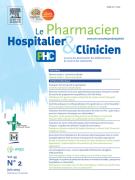Étude des interventions pharmaceutiques dans deux services cliniques à l’hôpital tunisien universitaire Sahloul - 03/06/16
 : Pharmacienne résidente en pharmacologie, D. Ghedira a, b : Pharmacienne assistante hospitalo-universitaire en chimie organique, A. Hassairi a, b : Pharmacienne professeur agrégée en chimie analytique
: Pharmacienne résidente en pharmacologie, D. Ghedira a, b : Pharmacienne assistante hospitalo-universitaire en chimie organique, A. Hassairi a, b : Pharmacienne professeur agrégée en chimie analytique| pages | 7 |
| Iconographies | 3 |
| Vidéos | 0 |
| Autres | 0 |
Résumé |
Introduction |
Dans le cadre d’une rationalisation de l’usage des médicaments, le pharmacien clinicien est amené à analyser les prescriptions médicales et à effectuer des interventions pharmaceutiques (IP) auprès des prescripteurs. L’objectif de ce travail est d’évaluer l’activité clinique de l’équipe pharmaceutique d’un centre hospitalo-universitaire tunisien au sein de deux services cliniques.
Matériel et méthodes |
Il s’agit d’une étude prospective, menée dans les services de chirurgie cardiovasculaire et thoracique (CCVT) et d’orthopédie, durant une période de quatre mois. Les prescriptions parvenant au service de pharmacie ont été analysées et validées selon la méthodologie de la Société française de pharmacie clinique (SFPC). Ainsi, tout problème pharmaco-thérapeutique (PPT) rencontré suscite une IP. Les données recueillies ont été analysées et classées par une fiche d’IP élaborée par la SFPC.
Résultats |
Un total de 68 PPT a été détecté avec une répartition presque équitable entre les deux services cliniques. Soixante-huit IP correspondantes ont été alors formulées. En considérant les avis pharmaceutiques émis suite à la sollicitation du prescripteur, le nombre d’IP global remonte à 92. Le taux d’acceptation médical global a été de l’ordre de 82,6 %. Les IP ayant un impact clinique non nul ont été à raison de 86 et 89 % respectivement pour le service d’orthopédie et le service de CCVT.
Discussion |
Comparée à l’activité de pharmacie clinique dans d’autres centres hospitaliers dans le monde, notre activité est considérée comme satisfaisante. Les IP réalisées étaient efficientes dans un grand nombre de cas et les taux d’acceptation par l’équipe médicale étaient assez élevés et comparables à ceux trouvés dans la littérature.
Conclusion |
Cette étude souligne l’importance du rôle du pharmacien hospitalier dans l’optimisation de la prise en charge thérapeutique du patient et la prévention des conséquences de certains traitements non convenablement conduits.
Le texte complet de cet article est disponible en PDF.Summary |
Introduction |
In order to rationalize drugs use and optimize patients’ treatment, the clinical pharmacist is required to analyse medical prescriptions and carry out pharmaceutical interventions (PI) in collaboration with physicians. The aim of our study is to evaluate the clinical activity of the pharmaceutical team in two clinical departments of a Tunisian University Hospital.
Materials and methods |
It is a prospective study, led in the departments of cardiovascular and thoracic surgery (CCVT) and orthopaedic surgery, over a period of four months. Prescriptions analysis and validation are done in the pharmacy department according to the methodology of the French Society of Clinical Pharmacy (SFPC). Thus, each identified pharmacotherapeutic problem (PTP) needs a PI. Data are then analysed and classified with a card of PI made by the SFPC.
Results |
A total of 68 PTP were detected with approximately equal distribution between the two clinical departments. So, 68 corresponding PI were formulated. In addition, 24 pharmaceutical opinions were carried out to respond to the requests of physicians. Thus, the global number of PI was 92. The global medical acceptance rate was estimated at 82.6 %. PI, with non-null clinical impact, were estimated at 86 and 89 % respectively for the orthopaedic surgery and CCVT departments.
Discussion |
Compared to the clinical pharmaceutical activity in other hospitals in the world, our activity is considered satisfactory. The PI made were efficient in a large number of cases, and the acceptance rates of the medical team are quite high and comparable to those found in the literature.
Conclusion |
This study highlights the important role of the clinician pharmacist in optimizing patients’ treatments and prevention of consequences of improperly led treatments.
Le texte complet de cet article est disponible en PDF.Mots clés : Intervention pharmaceutique, Pharmacien clinicien, Problème lié à la thérapeutique, Service clinique
Keywords : Pharmaceutical intervention, Clinical pharmacist, Pharmacotherapeutic problem, Clinical department
Plan
Vol 51 - N° 2
P. 116-122 - juin 2016 Retour au numéroBienvenue sur EM-consulte, la référence des professionnels de santé.
L’accès au texte intégral de cet article nécessite un abonnement.
Bienvenue sur EM-consulte, la référence des professionnels de santé.
L’achat d’article à l’unité est indisponible à l’heure actuelle.
Déjà abonné à cette revue ?

